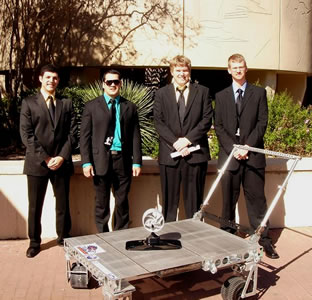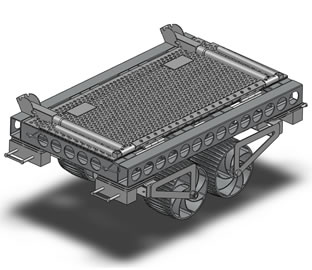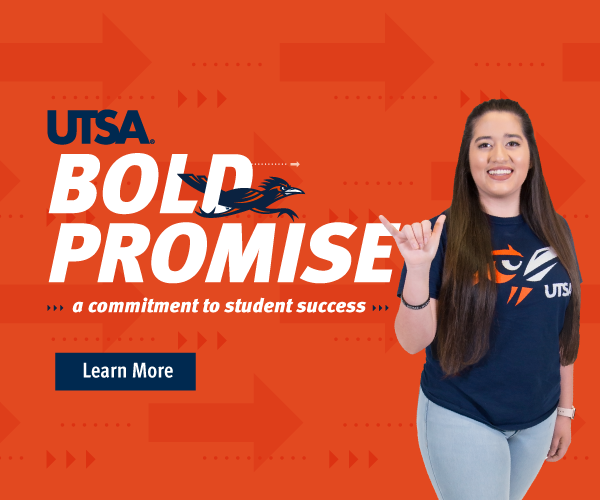UTSA mechanical engineering students win award for lunar utility cart design


Top: Lunar utility cart design team (from left) Luis Carlos Salinas, Philip Haberle, William Dunne and Chris Kite
Bottom photo: Lunar cart in collapsed position


Top: Lunar utility cart design team (from left) Luis Carlos Salinas, Philip Haberle, William Dunne and Chris Kite
Bottom photo: Lunar cart in collapsed position
(Dec. 15, 2009)--UTSA mechanical engineering students Luis Carlos Salinas, Chris Kite, William Dunne and Philip Haberle haven't begun their careers yet, but already they have collaborated with NASA to design a lunar utility cart. After building a prototype at a cost of slightly more than $500, the UTSA students were named the Texas Space Grant Consortium Design Challenge's fall 2009 Top Design Team.
"NASA plans to return to the moon in 2020, and the astronauts who make that journey will need novel equipment that is adapted to lunar conditions," said John Simonis, senior lecturer in the Department of Mechanical Engineering and one of the team's mentors. "The Texas Space Grant Consortium Design Challenge is one way engineering students can contribute to the development of NASA's new equipment solutions."
The lunar utility cart will allow astronauts to transport 500 earth pounds of cargo, experiments, geology samples and equipment on the rough terrain of the moon. Designed to withstand lunar temperature fluctuations, the cart also is collapsible for space launch and travel and easily operated by one crewmember.
The competition judges were particularly impressed with the cart's six-spoked wheel design. Based on the Mars exploration rovers, the wheels are wide enough to prevent the cart from bogging down in the soft dust on the moon's surface, and casters will allow the wheels to swivel 360 degrees. In the stowed position, the wheels lock.
The self-named Team No Boundaries is composed of four aspiring engineers who designed the lunar utility cart during the two-semester planning and design course sequence required of UTSA mechanical engineering majors. During the first semester, the team worked through ideas about cart shapes and attributes. In the second semester, they refined the design and built a prototype. During the design process, the team worked with NASA fellow and ergonomics expert Robert Trevino."Not just anyone gets to work with someone from NASA," said team member Salinas. "He provided a lot of NASA resources that we could use for our project. He helped us visualize how objects on the lunar surface behaved. He provided us a Web site with a whole lot of information about designing devices for space applications."
Team member Kite added, "Dr. Trevino encouraged us to reach forward and design the cart with a caution for an astronaut's ergonomics while staying within the constraints that NASA required. It was his welcoming personality that allowed us to keep on rocking."
The team received tips from UTSA mechanical engineering professor Yesh Singh, who specializes in mechanism design, machine element design, finite element applications in mechanical design and the mechanics of solids.
"Dr. Singh advised us in his areas of expertise," said Salinas. "He knows how materials behave in certain conditions. He advised us on the stress situations that could happen on the lunar surface."
To earn $1,650 in scholarship and other monies, Team No Boundaries bested a group of formidable teams at the design challenge including teams representing Lamar University, Texas A&M University, Texas Tech University and University of Texas at Austin. The Top Design Team award winners will receive a trophy, currently en route from the United Space Alliance. The trophy depicts a space shuttle model with signatures of NASA shuttle astronauts.
"The overwhelming success of our two teams in this important statewide competition is another indicator of the high quality of the mechanical engineering program at UTSA," said Efstathios Michaelides, professor and chair of the Department of Mechanical Engineering. "Our students have shown that they can compete very well with the best out there and win similar awards."
A possible next step is to visit NASA for "rock yard" field testing.
"We foresee NASA probably using some of the features and ideas in the design," said Salinas. "Dr. Trevino has suggested we take the cart to NASA's rock yard, an artificial lunar surface. We've also given thought to modifying the design for commercial use and patent that design. We'll see what happens."
-----------------------------
Cost of lunar utility cart
Casters: $90.87
Frame: $187.88
Wheels: $35.86 (not including machining cost)
Platform: $69.03
Handle: $97.16
Miscellaneous: $30.48
Total: $511.28
Events
The UTSA Office of Undergraduate is proud to celebrate National Undergraduate Research with an annual event sponsored by the (OUR) featuring students will showcase undergraduate student research and creative endeavors from all disciplines across campus.
Various LocationsThis community event is hosted by the UTSA Mexican American Studies Program. It is a lecture/performance that examines the contributions of Tejana musicians to the evolution of Mexican American music.
Esperanza Peace & Justice Center, 922 San Pedro Ave.Asian Fanfair is an event that highlights our APIDA (Asian Pacific Islander Desi American) identities on campus. The event will feature performances from our AAPI interest Student Organizations, a tabling fair, and some cultural cuisine.
Student Union Paseo, Main CampusJoin us for a day dedicated to supporting and empowering our UTSA veterans! We're excited to announce our upcoming resource fair, designed specifically to ensure that our veteran students have access to the resources and networking opportunities they need to thrive in their academic and post-military lives.
Student Union Lawn, Main CampusThis workshop will introduce participants to the basics of text analysis using Python and Jupyter Notebook on the Constellate Lab platform. We will create datasets in Constellate to analyze patterns, trends, and relationships of contents and more.
John Peace Library (JPL 3.02.32), Main CampusWhat would award-winning writing professor Diane Abdo say if it were her last lecture? Join us for our annual Last Lecture series on Wednesday April 17.
Multipurpose Room (BSE 2.102), Main CampusDía en la Sombrilla, formerly Fiesta UTSA, is a festival hosted each spring as a part of Fiesta® San Antonio events. Sponsored by Roadrunner Productions, the event features music, food, confetti, games, event t-shirts, and more.
Sombrilla Plaza and Central Plaza, Main Campus

